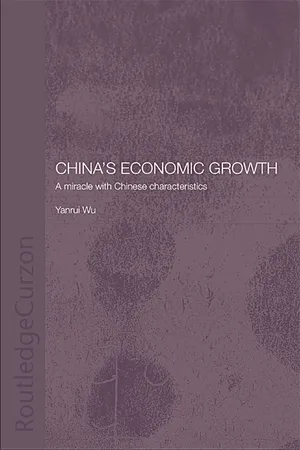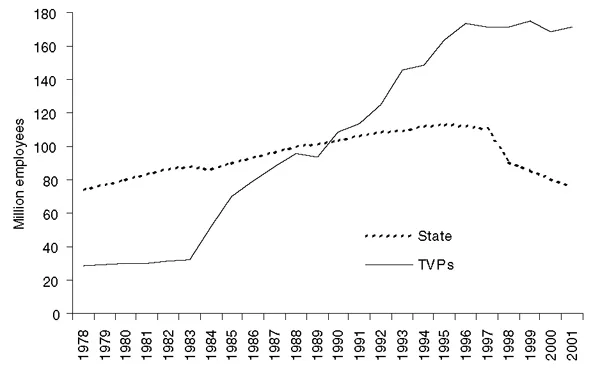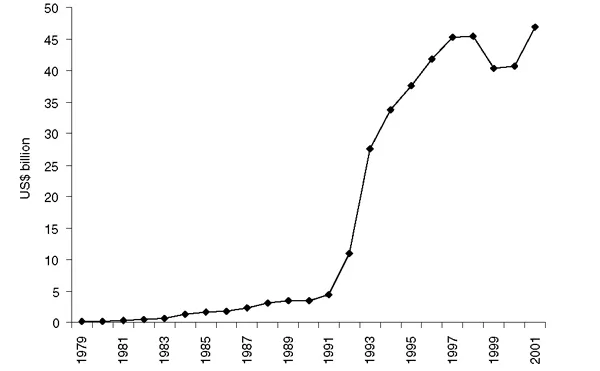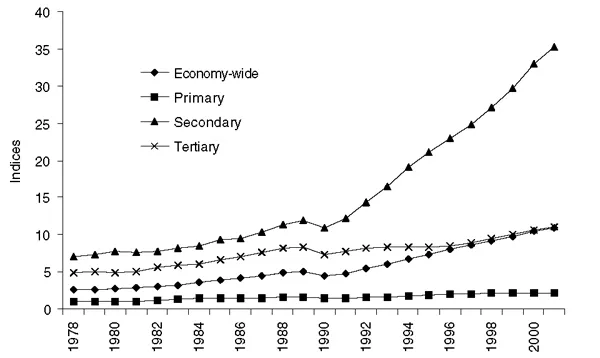1 Growing with Chinese characteristics
An introduction
The dramatic takeoff of the Chinese economy during the last two decades of the twentieth century has had significant impact on mankind in general and the Chinese people in particular. This is because of the fact that one-fifth of the earth’s inhabitants live in China and that the majority of them have now climbed out of poverty. For the same reason, understanding China’s recent economic success has occupied many authors in the profession. This book contributes to the growing pool of papers in the literature. The objectives of this introductory chapter are twofold: (a) to describe briefly the characteristics of China’s growth in the past two decades; and (b) to introduce an outline of the chapters.
1.1 Growth miracle with Chinese characteristics
The People’s Republic of China was founded in 1949. Its economic development over the past five decades can be divided into two periods: the post-reform and pre-reform periods. According to Figure 1.1, economic growth was extremely volatile in the pre-reform period (1954–77), with the rate of growth ranging from 21.3 per cent in 1958 to –27.3 per cent in 1961. Many authors have presented detailed studies of the pre-reform period (e.g., Rawski 1979, Dernberger 1980, Chow 1987 and Lin et al. 1996). In this volume, the focus is the post-reform period from 1978 onwards. Figure 1.1 clearly shows that China enjoyed sustained growth in the 1980s and 1990s. Though this growth slowed down in late 1990s, it still achieved a rate of 7 per cent in 2001 and is expected to reach 8 per cent in 2002. This growth is predicted to continue in the coming decade (Economic Analytical Unit 2002 and Asian Development Bank 2002).
China’s economic growth in recent decades has been driven by several important factors such as the development of the rural non-farming sector, massive inflow of foreign capital, structural transformation, reform-induced efficiency improvement and promotion of trade. There are some special features associated with these factors. The following sections present a brief description of these special features.
Figure 1.1 The rates of growth of the Chinese economy, 1954–2001
Source: State Statistical Bureau (various issues).
Development of the rural non-farming sector
China’s economic reform began in the farming sector in late 1970s. The reform was very successful and has led to dramatic improvement in efficiency (McMillan et al. 1989 and Lin 1992). As productivity increased in the farming sector, surplus rural labour emerged rapidly in the early 1980s. In the mean time, rural residents were prohibited from migrating to the cities due to the stringent household registration system. As a result, farmers developed their own industrial sector, that is the so-called rural township, village and private enterprises (TVPs). The growth and development of TVPs in China is distinct in the world and directly the result of rural–urban segmentation under the household registration system.1 Ironically, the TVP sector was the most dynamic sector and essentially became the main driving force for China’s economic growth in the 1980s. The spectacular growth of TVPs is illustrated in Figure 1.2. In terms of employment, the TVP sector overtook the state sector in 1990. In 2001, its size was more than twice as great as the state sector. Though individual TVPs vary in scale, some of them have become multinational companies such as Haier, a white goods producer based in Shangdong.
Massive inflow of foreign capital
Among the developing nations, China has for years been the most popular destination for foreign direct investment. In 2002 China for the first time overtook the United States as the world’s largest recipient of foreign capital. China’s success in attracting foreign investment has caught the headlines in the press. There is no doubt that foreign investment has played an important role in China’s recent growth.2 After the absence of foreign capital in its economy for decades, China received its first offshore investment in 1979 (see Figure 1.3). Since then, foreign companies have injected more than US$568 billion into the Chinese economy. Foreign capital created millions of jobs and contributed to a substantial proportion of China’s exports. The major hosting regions (e.g., Guangdong, Shanghai, Jiangsu, Shandong and Fujian) in China tend to enjoy a high rate of growth. The pattern of foreign capital flow seems to coincide with that of China’s high growth in the 1990s according to Figure 1.3.
Figure 1.2 Employment in Chinese State and TVP sectors, 1978–2001
Sources: State Statistical Bureau (various issues and 2002).
Structural transformation
Accompanied by economic growth there was rapid structural transformation in the Chinese economy in the past two decades. The trend is very similar to the pattern of changes undertaken by other countries (see Table 1.1). That is, as an economy develops, the primary sector declines and the service sector expands in terms of both employment and income shares. What is special about China is that the employment share of agricultural sector falls relatively slowly. Once again, this situation may be due to China’s population policy which for many years restricts rural out-migration.
Figure 1.3 Foreign direct investment in China, 1979–2001
Sources: State Statistical Bureau (various issues and 2002).
Table 1.1 Sectoral shares of GDP and employment in China (%)
Source: State Statistical Bureau (2002).
Notes I, II and III represent the primary, secondary and tertiary sectors, respectively.
Reform-induced efficiency improvement
One of the main goals of economic reform in China was to improve efficiency in the economy. Has this goal been achieved?3 The answer to this question is clearly demonstrated in Figure 1.4. According to this chart, labour productivity has increased rapidly in China in the past two decades, particularly in the 1990s. There is however considerable variation among the three sectors. The secondary sector has been the main driver of productivity growth. The primary sector experienced only modest growth. The economy-wide trend is a continuing increase in productivity during 1978–2001.
Figure 1.4 Labour productivity indices in the Chinese economy, 1978–2001
Sources: State Statistical Bureau (various issues and 2002).
Note: The indices are relative to labour productivity in the primary sector in 1978 (unity).
Promotion of trade
China has followed the East Asian model of development by encouraging foreign trade, in particular exports. Trade expanded rapidly in the past two decades, especially in the 1990s (Figure 1.5). Trade not only generated China’s much needed foreign exchange but also promoted technology transfer and brought about competition in the former centrally planned system. China’s total trade amounted to US$509.8 billion in 2001, being the sixth largest in the world. There is no doubt that trade has played an important role in China’s recent growth.4
Summary
In summary, China’s growth greatly benefited from economic reforms initiated in the late 1970s. One of the key reform initiatives was the open-door policy. Under that policy, China embraced foreign trade and investment. With China becoming an official member of the World Trade Organization (WTO) in November 2001, the Chinese economy will become more liberalised and the Chinese market more accessible in the near future. In the meantime, China will attract more foreign investment and Chinese firms will face more competition from foreign counterparts. These changes will affect China’s growth in the twenty-first century. This volume contributes to the understanding of China’s economic growth and attempts to examine some of the issues associated with growth in the Chinese economy, among its regions and in selected industries. An outline of the chapters is presented in the following section.
Figure 1.5 Indices of China’s exports and imports, 1978–2001
Source: State Statistical Bureau (2002).
Note: The indices are relative the value of exports in 1978 (unity).
1.2 Outline of the chapters
The core body of this book consists of seven chapters (Table 1.2). They are partitioned into three parts. Part I deals with growth at the macro level. It begins with Chapter 2 which presents estimates of capital stock in China and its regions. These data series are used in other chapters and made available for other researchers (see the appendix to this book). Chapter 2 also briefly examines the relationship between capital formation and growth. However, more detailed investigations of the impact of capital formation on economic growth are partially presented in Chapters 3 and 4. The focus of Chapter 3 is the source of economic growth. Some key economic and policy variables are considered in this chapter. They include capital stock, human capital, economic reform, infrastructure, initial conditions, openness, productivity and foreign capital. In this chapter, appropriate indices or measures are developed for each of these variables. A regression approach is applied to assess the impact of these variables on economic growth. The final chapter in Part I is Chapter 4 which explores the role of productivity in China’s economic growth in the 1980s and 1990s. The approach applied extends the traditional growth accounting technique. According to the extended technique, growth is decomposed into three components associated with factor inputs, efficiency change and technological progress, respectively. Each component is potentia...





